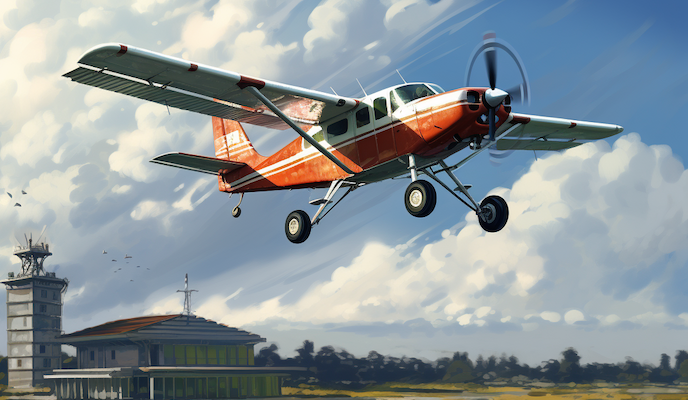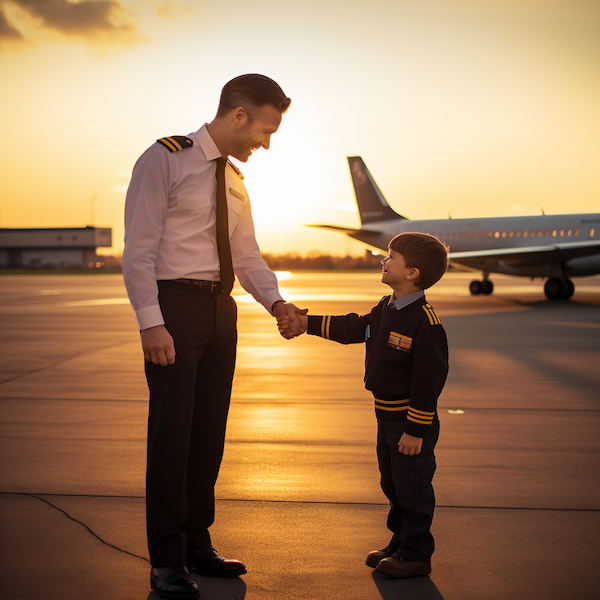If you are passionate about flying and want to make it your career, you might have wondered how to become a commercial pilot. Being a commercial pilot is not only a lucrative and prestigious profession, but also a challenging and rewarding one. However, becoming a commercial pilot is not as simple as hopping on a plane and taking off. It requires extensive and rigorous training, both theoretical and practical, to meet the high standards of the aviation industry.
There are different training programs to become a commercial pilot, depending on your goals, preferences, and budget. Each program has its own advantages and disadvantages, as well as different requirements and costs. In this blog post, I will share with you some of the most popular and widely recognized training programs to become a commercial pilot. I will also mention some of the countries where these programs are more beneficial for aspiring pilots.
1: Integrated Program
 The integrated program is a full-time and intensive training program that takes you from zero experience to a fully qualified commercial pilot in about 18 months. The program covers all the necessary ground school and flight training, as well as additional modules such as multi-crew cooperation (MCC), jet orientation course (JOC), and airline preparation course (APC). The program also provides you with an airline transport pilot licence (ATPL) theory credit, which is required for most airline careers.
The integrated program is a full-time and intensive training program that takes you from zero experience to a fully qualified commercial pilot in about 18 months. The program covers all the necessary ground school and flight training, as well as additional modules such as multi-crew cooperation (MCC), jet orientation course (JOC), and airline preparation course (APC). The program also provides you with an airline transport pilot licence (ATPL) theory credit, which is required for most airline careers.
The integrated program is ideal for those who want to fast-track their career and have a clear goal of becoming an airline pilot. The program is also highly regarded by many airlines, as it ensures a high level of standardization and quality among the graduates. However, the integrated program is also very expensive, costing between C$100,000 and C$150,000 for the whole process. The program is also very demanding, requiring full commitment and dedication from the students.
Some of the benefits of the integrated program are:
- You can complete your training in a shorter time than other programs.
- You can gain access to exclusive facilities, resources, and instructors that are affiliated with the program.
- You can increase your chances of getting hired by major airlines that prefer or require graduates from integrated programs.
Some of the drawbacks of the integrated program are:
- You have to pay a large amount of money upfront or take out a loan to finance your training.
- You have to follow a strict schedule and curriculum that may not suit your learning style or pace.
- You have to relocate to where the program is offered or travel frequently to attend classes and sessions.
Some of the countries where the integrated program is more beneficial are:
- United Kingdom: The United Kingdom has a strong and reputable aviation industry, with many renowned flight schools that offer integrated programs. The United Kingdom also has a high demand for pilots, especially in the major airlines such as British Airways, Virgin Atlantic, and EasyJet. The United Kingdom also has a close relationship with the European Union, which allows UK pilots to fly in EU airspace without additional requirements.
- Singapore: Singapore is another country with a leading and prestigious aviation industry, with many opportunities for airline pilots in various sectors and regions. Singapore also has a high standard of training and safety, which makes it attractive for foreign pilots to work in Singapore. Singapore also has a strategic location in Asia, which allows Singaporean pilots to fly to many destinations around the world.
- United Arab Emirates: The United Arab Emirates is a country with a booming and innovative aviation industry, with many opportunities for airline pilots in various sectors and regions. The United Arab Emirates also has a high demand for pilots, especially in the major airlines such as Emirates and Etihad, which offer lucrative salaries and benefits. The United Arab Emirates also has a diverse and multicultural environment, which makes it enjoyable for foreign pilots to work in the UAE.
2: Modular Program
The modular program is a flexible and self-paced training program that allows you to complete your commercial pilot licence (CPL) in stages or modules. The program covers all the necessary ground school and flight training, but you can choose when and where to do each module according to your availability and budget. The program also allows you to work or study while you train, as well as gain valuable flying experience along the way.
The modular program is ideal for those who want to have more control over their training schedule and costs. The program is also more affordable than the integrated program, costing between C$50,000 and C$100,000 for the whole process. However, the modular program is also more time-consuming than the integrated program, taking between 2 years and 4 years to complete your CPL. The program is also less preferred by some airlines, as it may not provide the same level of standardization and quality among the graduates.
Some of the benefits of the modular program are:
- You can customize your training according to your needs, preferences, and goals.
- You can save money by choosing cheaper or local flight schools or instructors for each module.
- You can balance your training with other commitments such as work, study, or family.
Some of the drawbacks of the modular program are:
- You have to spend more time and effort to complete your training than other programs.
- You have to manage your own progress and quality of training for each module.
- You have to face more competition and challenges to get hired by major airlines that prefer or require graduates from integrated programs.
Some of the countries where the modular program is more beneficial are:
- Canada: Canada has a large and diverse aviation industry, with many flight schools and flying clubs across the country that offer modular programs. Canada also has an agreement with the United States that allows Canadian CPL holders to fly in US airspace without additional requirements. Canada also has favorable weather conditions for most of the year, which makes flying more enjoyable and convenient.
- Australia: Australia is another country with a vibrant aviation culture and plenty of opportunities for recreational and commercial flying. Australia has a vast and varied terrain, from deserts to mountains to coastlines, that offers scenic views and challenges for pilots. Australia also has a reciprocal agreement with New Zealand that allows Australian CPL holders to fly in New Zealand airspace without additional requirements.
- South Africa: South Africa is a country with a rich history and culture, as well as stunning natural beauty. South Africa has many flight schools and flying clubs that offer affordable and quality training for CPL holders. South Africa also has favorable weather conditions for most of the year, which makes flying more enjoyable and convenient.
3: University Program

The university program is an academic and professional training program that combines a bachelor’s degree in aviation or a related field with a commercial pilot licence (CPL). The program covers all the necessary ground school and flight training, as well as additional modules such as multi-crew cooperation (MCC), jet orientation course (JOC), and airline preparation course (APC). The program also provides you with an airline transport pilot licence (ATPL) theory credit, which is required for most airline careers.
The university program is ideal for those who want to have a well-rounded education and a competitive edge in the aviation industry. The program is also recognized by many airlines, as it ensures a high level of knowledge and skills among the graduates. However, the university program is also very expensive, costing between C$150,000 and C$200,000 for the whole process. The program is also very demanding, requiring both academic and practical excellence from the students.
Some of the benefits of the university program are:
- You can earn a bachelor’s degree in aviation or a related field that can enhance your career prospects and opportunities.
- You can access advanced facilities, resources, and instructors that are affiliated with the university and the program.
- You can network with other students, alumni, and professionals who share your passion and interest in aviation.
Some of the drawbacks of the university program are:
- You have to pay a large amount of money upfront or take out a loan to finance your education and training.
- You have to follow a strict schedule and curriculum that may not suit your learning style or pace.
- You have to relocate to where the university and the program are offered or travel frequently to attend classes and sessions.
Some of the countries where the university program is more beneficial are:
- United States: The United States has one of the largest and most diverse aviation markets in the world, with many opportunities for commercial pilots in various sectors and regions. The United States also has many reputable universities that offer aviation degrees and CPL training. The United States also has a flexible and streamlined process for converting foreign licences to US licences, which makes it easier for foreign pilots to work in the US.
- United Kingdom: The United Kingdom is another country with a strong and dynamic aviation industry, with many opportunities for commercial pilots in various sectors and regions. The United Kingdom also has many reputable universities that offer aviation degrees and CPL training. The United Kingdom also has a close relationship with the European Union, which allows UK pilots to fly in EU airspace without additional requirements.
- India: India is a country with a fast-growing and emerging aviation market, with many opportunities for commercial pilots in various sectors and regions. India also has many reputable universities that offer aviation degrees and CPL training. India also has a large population and a growing middle class, which creates a high demand for air travel and pilots. India also has a low cost of living and training, which makes it affordable for aspiring pilots to pursue their CPL.
4: Pilot Cadet Program
The pilot cadet program is a sponsored and selective training program that offers you a guaranteed job as a commercial pilot with a specific airline upon completion.
The program covers all the necessary ground school and flight training, as well as additional modules such as multi-crew cooperation (MCC), jet orientation course (JOC), and airline preparation course (APC). The program also provides you with an airline transport pilot licence (ATPL) theory credit, which is required for most airline careers.
The pilot cadet program is ideal for those who want to have a secure and direct career path to an airline pilot. The program is also advantageous for those who want to reduce their financial risk, as the airline sponsors part or all of the training costs. However, the pilot cadet program is also very competitive, requiring high academic performance, aptitude tests, interviews, and assessments. The program is also very binding, requiring you to sign a contract with the airline for a certain period of time.
Some of the benefits of the pilot cadet program are:
- You can get a guaranteed job offer from a specific airline before you start your training.
- You can get financial support from the airline for part or all of your training costs.
- You can get access to exclusive facilities, resources, and instructors that are affiliated with the airline and the program.
Some of the drawbacks of the pilot cadet program are:
- You have to pass a series of tests and interviews to get accepted into the program.
- You have to commit to work for the airline for a certain period of time after you complete your training.
- You have to follow a strict schedule and curriculum that may not suit your learning style or pace.
Some of the countries where the pilot cadet program is more beneficial are:
- Singapore: Singapore is a country with a leading and prestigious aviation industry, with many opportunities for airline pilots in various sectors and regions. Singapore also has one of the most renowned pilot cadet programs in the world, offered by Singapore Airlines. The program covers all the training costs and provides a monthly allowance for the cadets. The program also guarantees a job as a first officer with Singapore Airlines upon completion.
- Germany: Germany is another country with a strong and reputable aviation industry, with many opportunities for airline pilots in various sectors and regions. Germany also has one of the most established pilot cadet programs in Europe, offered by Lufthansa. The program covers part of the training costs and provides low-interest loans for the cadets. The program also guarantees a job as a first officer with Lufthansa or one of its subsidiaries upon completion.
- Australia: Australia is another country with a vibrant aviation culture and plenty of opportunities for commercial flying. Australia also has one of the most innovative pilot cadet programs in Asia-Pacific, offered by Qantas. The program covers part of the training costs and provides scholarships for some cadets. The program also guarantees a job as a first officer with Qantas or one of its subsidiaries upon completion.
5: Airline Mentorship Program

The airline mentorship program is a supportive and collaborative training program that offers you a conditional job offer as a commercial pilot with a specific airline upon completion. The program covers all the necessary ground school and flight training, as well as additional modules such as multi-crew cooperation (MCC), jet orientation course (JOC), and airline preparation course (APC). The program also provides you with an airline transport pilot licence (ATPL) theory credit, which is required for most airline careers.
The airline mentorship program is ideal for those who want to have a personalized and guided career path to an airline pilot. The program is also advantageous for those who want to benefit from the expertise and network of the airline, as the program provides mentoring, coaching, and feedback from experienced pilots. However, the airline mentorship program is also self-funded, requiring you to pay for all the training costs. The program is also conditional, requiring you to meet certain performance and eligibility criteria throughout the training.
Some of the benefits of the airline mentorship program are:
- You can get a conditional job offer from a specific airline before you start your training.
- You can get mentoring, coaching, and feedback from experienced pilots who work for the airline.
- You can get access to exclusive facilities, resources, and instructors that are affiliated with the airline and the program.
Some of the drawbacks of the airline mentorship program are:
- You have to pay for all your training costs by yourself or take out a loan to finance your training.
- You have to meet certain performance and eligibility criteria throughout your training to keep your conditional job offer.
- You have to follow a strict schedule and curriculum that may not suit your learning style or pace.
Some of the countries where the airline mentorship program is more beneficial are:
- United States: The United States has one of the largest and most diverse aviation markets in the world, with many opportunities for commercial pilots in various sectors and regions. The United States also has many reputable airlines that offer mentorship programs, such as Delta, United, American, Southwest, and JetBlue. The programs vary in their benefits, but they all provide a pathway to becoming a professional pilot for their respective airlines.
- United Kingdom: The United Kingdom is another country with a strong and dynamic aviation industry, with many opportunities for commercial pilots in various sectors and regions. The United Kingdom also has many reputable airlines that offer mentorship programs, such as British Airways, Virgin Atlantic, EasyJet, and Ryanair. The programs vary in their benefits, but they all provide a pathway to becoming a professional pilot for their respective airlines.
- Canada: Canada is another country with a large and diverse aviation industry, with many opportunities for commercial pilots in various sectors and regions. Canada also has many reputable airlines that offer mentorship programs, such as Air Canada, WestJet, Porter, and Air Transat. The programs vary in their benefits, but they all provide a pathway to becoming a professional pilot for their respective airlines.
6: Military Service

The military service is a patriotic and honorable training program that offers you a chance to serve your country as a commercial pilot upon completion. The program covers all the necessary ground school and flight training. The program also provides you with an airline transport pilot licence (ATPL) theory credit, which is required for most airline careers.
The military service is ideal for those who want to have a noble and challenging career path to an airline pilot. The program is also advantageous for those who want to gain valuable flying experience and skills in various aircraft types and missions. However, the military service is also very demanding, requiring physical fitness, mental toughness, discipline, and loyalty. The program is also very binding, requiring you to sign a contract with the military for a certain period of time.
Some of the benefits of the military service are:
- You can serve your country and contribute to its security and defense.
- You can gain flying experience and skills in various aircraft types and missions that are not available in civilian aviation.
- You can get paid while you train and enjoy other benefits such as health care, pension, and education.
Some of the drawbacks of the military service are:
- You have to pass a series of tests and interviews to get accepted into the service.
- You have to commit to work for the military for a certain period of time after you complete your training.
- You have to face risks and dangers that are inherent in military operations.
Some of the countries where the military service is more beneficial are:
- France: France is a country with a proud and respected military tradition, with many opportunities for commercial pilots in various sectors and regions. France also has one of the most prestigious military academies in the world, the École de l’Air. The academy offers a comprehensive training program for aspiring pilots who want to join the French Air Force. The program also guarantees a job as a commercial pilot with Air France upon completion.
- Israel: Israel is another country with a proud and respected military tradition, with many opportunities for commercial pilots in various sectors and regions. Israel also has one of the most rigorous and selective training programs for aspiring pilots who want to join the Israeli Air Force. The program offers a comprehensive training program for aspiring pilots who want to join the Israeli Air Force. The program also guarantees a job as a commercial pilot with El Al upon completion.
- Brazil: Brazil is another country with a proud and respected military tradition, with many opportunities for commercial pilots in various sectors and regions. Brazil also has one of the most renowned military academies in South America, the Academia da Força Aérea. The academy offers a comprehensive training program for aspiring pilots who want to join the Brazilian Air Force. The program also guarantees a job as a commercial pilot with LATAM upon completion.
Conclusion
As you can see, there are different training programs to become a commercial pilot, depending on your goals, preferences, and budget. Each program has its own advantages and disadvantages, as well as different requirements and costs. However, all programs share one thing in common: they require passion, dedication, and hard work. Becoming a commercial pilot is not an easy feat, but it is definitely worth it once you achieve your dream of flying.
I hope this blog post has given you some insight into how to become a commercial pilot and inspired you to pursue your aviation aspirations. If you have any questions or comments, please feel free to leave them below. Thank you for reading and happy flying!

